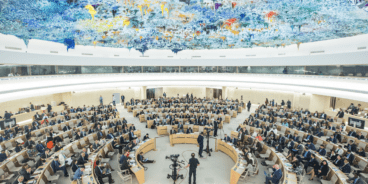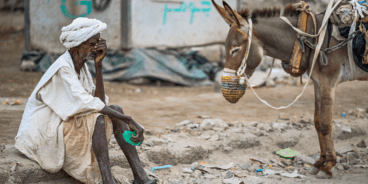
Libya and the Responsibility to Protect: Results and Prospects
Dr. Simon Adams published the following article in Global Policy Journal on 28 March 2014. The article is part of Global Policy’s e-book, ‘Lessons from Intervention in the 21st Century: Legality, Legitimacy and Feasibility’, edited by David Held and Kyle McNally.
From the start of Libyan dictator Muammar al-Qaddafi’s bloody suppression of “Arab Spring” protests in February 2011, the developing international norm of the “Responsibility to Protect” (R2P) informed the UN Security Council’s response. While R2P had played some role in deescalating deadly ethnic conflict in Kenya during 2008, it had never been utilized by the Security Council to authorize coercive action against a UN member state before. It was for this reason that Resolution 1970 of 26 February was hailed as a historic diplomatic moment. Correspondingly, Resolution 1973, which followed on 17 March, was initially seen as a timely and proportional intervention to protect civilians at grave risk of mass atrocities.
During the three weeks between the adoption of resolutions 1970 and 1973, escalating violence prompted the African Union, Arab League and other international organizations to urge Qaddafi to stop the killing and resolve the crisis peacefully. Despite these efforts, by 16 March pro- Qaddafi forces were approaching the opposition stronghold of Benghazi. Libyan television broadcast a message that the army was coming “to cleanse your city.” Qaddafi directly threatened Benghazi’s residents, saying that the army was on its way and that “we will show no mercy and no pity.”
It was the impending assault on Benghazi that moved the Security Council to pass Resolution 1973. The fact that it was adopted without a single negative vote reflected that, at the time, even those with serious reservations about a NATO-led operation, most notably Russia and China, recognized that the world needed to act.
Over the course of the following months the debate regarding the meaning of the resolutions and their implementation became increasingly bitter at UN headquarters in New York. Some member states argued that the civilian protection operation in Libya had been expeditiously coopted by Western partisans of “regime change.” The alternative view was that the “all necessary measures” clause in Resolution 1973 was being utilized by the NATO-led alliance to prevent further atrocities and protect civilians. Questions of proportionality and motivation began to undermine the consensus that initially existed.
In particular, there was a growing view that NATO was no longer acting solely as a defensive shield for populations at risk, but as the Libyan rebels’ airforce. India’s Ambassador to the UN, Hardeep Singh Puri, described NATO as the “armed wing” of the Security Council and argued that the objective in Libya had casually shifted from protecting civilians in Benghazi to overthrowing the regime in Tripoli.
In the final analysis, however, international military intervention in Libya saved lives. By 26 February, when Resolution 1970 was passed, it was already clear that Qaddafi was willing to use whatever means available to crush a rapidly developing uprising against four decades of eccentric dictatorship. Qaddafi’s heir apparent, his son Saif al-Islam, appeared on Libyan television warning of “rivers of blood” that would flow if the rebellion did not stop. Invoking language that was reminiscent of the 1994 genocide in Rwanda, Qaddafi himself described protesters as drug-crazed “rats” and “cockroaches.” He promised to “cleanse Libya house by house.” These were not idle threats. The International Criminal Court later estimated that 500 to 700 civilians were killed by state forces during February, prior to the outbreak of civil war.
The fall of Qaddafi’s government in August 2011, the challenges of rebuilding from the ruins of civil war and the destabilizing flow of Libyan weapons across the Sahel, meant that Libya continued to provide a focus for debates over R2P. Three years later, growing lawlessness and deadly disputes between fractious militias ensure that the debate over the costs and benefits of foreign military intervention in Libya is not entirely over. More immediately, however, the contrast between the Security Council’s response in Libya and its inability to take timely and decisive action with regard to mass atrocities in nearby Syria widened the divide between supporters and critics of R2P.
If for some critics Libya represented a possible case of R2P-overreach, Syria is yet another tragic example of dysfunction and deadlock inside the UN Security Council. Similarly inspired by the Arab Spring uprisings across the region, in mid-March 2011 mass protests broke out in Syria. With the Security Council distracted by Libya, and with Russia a long-standing ally, the government of President Bashar al-Assad was able to prevaricate and break numerous promises to reform. As the popular uprising degenerated into a bitter civil war the Security Council was left immobilized.
Between March 2011 and July 2012, despite ongoing mass atrocity crimes, Russia and China vetoed three Security Council resolutions that sought to impose sanctions, an arms embargo and travel bans upon the Syrian government. Russian Foreign Minister Sergei Lavrov insisted that, “We’ll not allow the Libyan experience to be reproduced in Syria,” as if the principle danger in Syria was another NATO-led military intervention. Russia’s position was allegedly one of principled neutrality, despite its long-term ties to the Assad regime and the fact that most atrocities in Syria were being perpetrated with Russian-supplied weapons. The three vetoes were also an explicit challenge to the notion of an international Responsibility to Protect.
In the aftermath of Libya, Brazil attempted to bridge the diplomatic divide at the UN by publishing a short paper on the “Responsibility while Protecting” (RWP) during November 2011. The essence of RWP was that military force must be a last resort, that any response must be proportional to the threat posed and that no intervention should cause more harm than it seeks to prevent. RWP resuscitated meaningful dialogue at the UN around both the preventive core of R2P and the potential need, post-Libya, for prudential criteria for use-of-force mandates by the Security Council.
While the media at times portrayed the inability of the Security Council to agree about Syria to be the result of the alleged misuse of R2P in Libya, the real problem was a deeper division between the Permanent Members of the Council regarding the contours of the international order in the early twenty-first century. Russian and Chinese hostility to action aimed at constraining the Syrian regime was linked to a strategic clash between the P2 (Russia and China) and the P3 (United States, United Kingdom and France) on a range of situations and thematic issues from Syria and Sudan to the future of UN peacekeeping. R2P was a symptom of this malady, not the cause.
Moreover, despite deep cracks within the Security Council, it still continued to invoke R2P in other contexts and situations that posed a threat to international peace and security. In the five years prior to the Libya intervention the Security Council had passed only four resolutions which referenced R2P – two were thematic resolutions on the protection of civilians, the other two concerned crises in the Democratic Republic of the Congo and Darfur, Sudan. By contrast, in less than three years following Resolution 1973, the Security Council passed eleven resolutions that directly referenced R2P. One of these concerned the trade in small arms, while the others confronted the threat of mass atrocities in Cote d’Ivoire, Yemen, Mali, Sudan, South Sudan and Central African Republic.
The reality is that Syria and Libya both moved R2P from moral abstraction to practical debates about implementation. As UN Secretary-General Ban Ki Moon argued with regard to R2P at the end of 2011, “I would far prefer the growing pains of an idea whose time has come to sterile debates about principles that are never put into practice.” Three years later, Libya should be understood in this context.
Dr. Simon Adams is Executive Director of the Global Centre for the Responsibility to Protect. He has worked extensively with governments and civil society organizations in South Africa, East Timor, Rwanda, Mozambique, Zimbabwe and elsewhere. Between 1994 and 2002 Dr. Adams worked with Sinn Féin and former IRA prisoners in support of the Northern Ireland peace process. He is also a former anti-apartheid activist and member of the African National Congress.
Related Content


Atrocity Alert No. 443: Sudan, Israel and the Occupied Palestinian Territory and United States Travel Ban
